How/Why You Use Your Journals?
Mr. Sellers,
My wife will happily tell you that I spend WAY too much time fussing over stationary and pens. Nonetheless, it’s a joy for me. I’m always curious how creative and productive people do their work. You have tons of content on how you use woodworking tools. I’d love to learn more about how you use your notebooks.
Do you, for instance, have one notebook going all the time? Or do you have books for particular projects or types of projects? Do you have a brand or a style of notebook you prefer? I suspect you’d prefer one that lays flat when opened.
Your sketching chops are admirable! Do you have a favorite resource for learning and developing those skills?
I’m also curious about how you plan and manage a project’s workflow. Maybe this is something you don’t think about often, especially for pieces you’ve built many times. If you’re building something new, though, do you work out an “order of operations” first? Forgive me if the answers to my questions are in your blog someplace.
I’m still exploring! You’ve written about the essentiality of drawing. I journal and sketch as well! My favorite notebooks have been Moleskines, but I was recently stranded without one for a few days and turned to a legal pad. I loved having the extra surface! Now I want to try a larger format “full time” notebook. I’d love any recommendations you have.
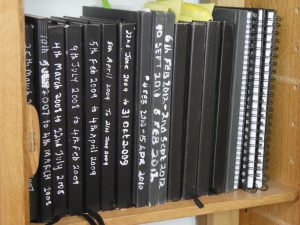
Thanks for your work and the marvelous content you provide!
@llen
Answer:
First of all I don’t like throwaway pads but I understand what you say about legal pads. For the rest of the world a legal pad is a USA size of notepad so it’s similar but not the same as an A4. A bit like a larger sized school refill pad. I used to use these but they seemed to be always telling me, “throwaway, throwaway!” when something inside kept saying, “Don’t lose it, don’t lose it.” So everything I wrote on legal pads was indeed thrown away because of its temporariness and I have almost no notes or records before say 15 years ago. Then one day I said to myself that I was losing valuable stuff from my life not the least of which was my drawings that tended to have blue lines equally spaced throughout them. An art professor in one of my classes kept very random notes of her progress in her sketchbook.
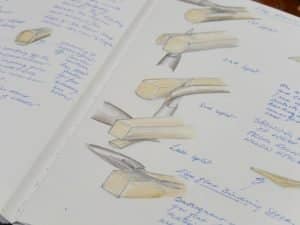
Though annoyingly random, she did indeed keep everything and had a total reference to look back on and rely on. I went out and bought the one made by or for Barnes and Noble called Sketchbook Punctuate which is trademarked by Barnes and Noble USA. It costs about $10 and has 192 pages so 96 sheets of acid-free 8” x 11” (7 1/2 x 11” actual useable surface) white sketching pages. Each page is perforated for easy removal but they stay in place too, so you don’t need to worry about losing a sheet accidentally. It also has a satin ribbon marker for keeping you page, which I do find handy. The ISBN-13:978-064158603-3. I like the smoothness of the paper as it only minimally influences the drawing texture and it doesn’t bleed when I use fine liners for pen and ink drawings or indeed technical drawings with technical pens. The drawings in my new book came from these sketchbooks which I tend to call journals because a write, note and sketch in them depending on what I want.
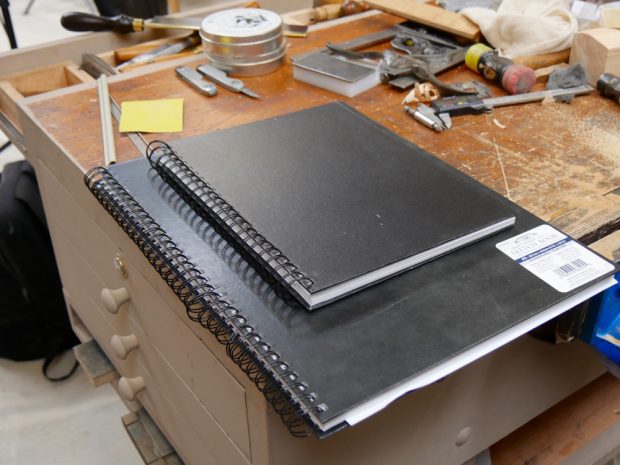
I also use Windsor and Newton wire bound sketchbooks regularly too. In many ways these are better because they do lie flat but I do not like the wire binding for the spine generally. I have just got used to them. I only like the way they seem to catch on everything and often a ring will end up deformed in some way and the pages don’t turn until corrected. These are useful for larger format so my main ones are 8 1/2” x 11 3/4” of useable surface. The next size I like is the UK A3 sketchbook size 11 3/4” x 16 1/2”. This allows for larger detail say in technical drawings and such but it also allows bolder sketching I might use for my work. Drawing is an ultra important skill that computer skills cannot at all match but I know this might well cause a negative response. CAD may be OK for technical drawings. No one is knocking that, but there are drawings computers create and in many ways people are robbed of developing skills that never emerged because of the computer and because they never had the opportunity to fully develop skills as yet undiscovered and undeveloped or under developed. The one thing that drawing of any kind does is it makes you look and it makes you see and it makes you understand what otherwise escapes the eye. In my view if you haven’t drawn it you haven’t seen it. I was pleased that my drawings made it into my book because they bring that part of me into the book that expresses what I feel about shape and flex, sinew, muscle, pressure and much, much more.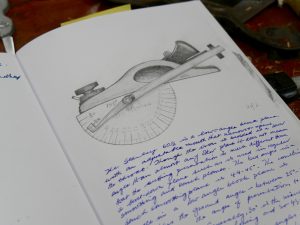
I do use a single journal at a time but this is the one I also write as a daily record of my day. In this case I write the date and day as an organised record. In large sketch books I don’t do this so this is not usually date worthy though most likely my sketches will be dated. Because by nature journals show a continuum of workdays and the work in progress they do end up as sequential references.
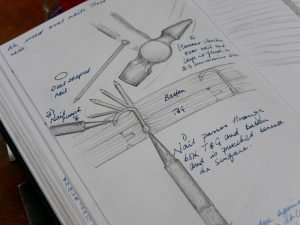
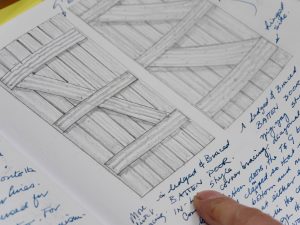
Writing makes you think through the making stages. My writing will mostly be notes to myself to engage myself with my imagined process even though many procedures are very standard; rough cut to size, surface plane the first registration face, search the grain for issues such as colour or figuring suitability, damage, flaws, joinery suitability and so on. Notes accompanied by drawings records my thoughts on such specific issues. I don’t think that this is a common practice but today I can testify to the absolute value of this throughout my worklife. Writing and drawing minimises mistakes that can be very expensive in time and materials and then wasted energy, emotion all of which will drain any craftsman.
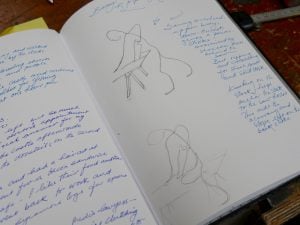
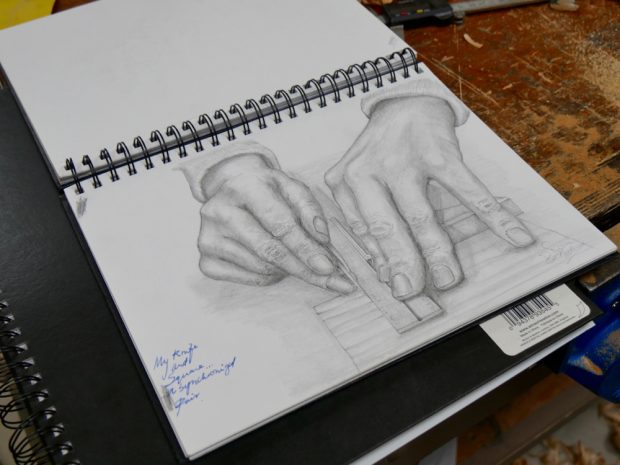
My journal has rough notes on pages next to developed and more formal notes including cutting lists but then I have a rough-work page where I scratch out quick points on any issue I don’t want to lose. Writing or drawing sketches record a concept and thought more as an aid to memory and this saves me regret when I might not remember a key thought pertinent to my writing or drawing or whatever else I think is important.
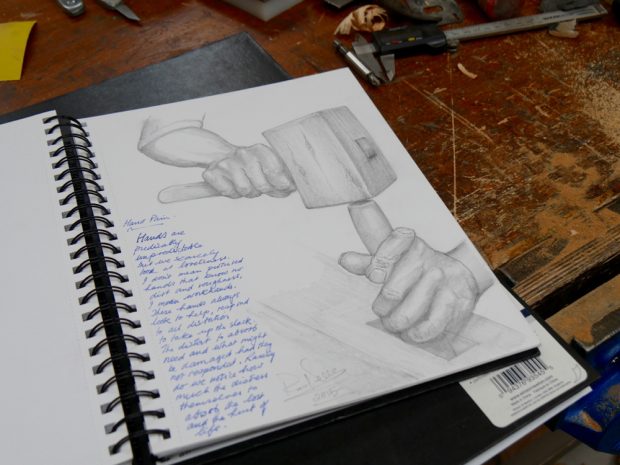


what would we know of that DaVinci guy without his journals – and he could draw too!
I love your writing style Paul and you do so with the ability to convey more information than most writers do. Reading many wood working sites one might think that everything is carved in stone with absolutely zero wiggle room for creativity which of course we know is not true. There is more to think about other than only the task of building and making things. You have years of stories about the things you’ve learned and the people you’ve learned from along with the people you’ve taught. I very much enjoy reading your blogs and someday books (as soon as I budget that into my monthly spending).
Have you ever given thought to a work of fiction that has a master cabinet maker as the lead? MURDER! INTRIGUE! ROMANCE and all that jazz? It’s not as if your workshop is lacking for instruments of destruction.
I’m kidding of course, but you do have a wonderful style that is unique and very enjoyable.
I too am keeping a journal not only for myself but for my future grandchild or grandchildren who will get this woodworking gene. I specifically chose a an ancient looking book that is leather bound but unfortunately the paper isn’t very good at all even though handmade it bleeds through and tears easily if you use a quill pen. Ordinary pens also don’t work too well so I’m using a calligraphy texta. The book was very expensive to buy in my view definitely not worth the money only because of it’s construction but when I’m done with it I’ll find someone who can make one for me and one that is easy to write on with a quill pen.
My youngest son I have made the custodian of this book after my passing and of all my tools, he has been given strict instructions never to sell them unless driven by poverty God forbid but to pass them on to that child who is passionate about learning the craft.
People work hard to leave mass wealth to their children in the end they squander it but I work hard to leave my knowledge and tools so they can earn their living.
An instruction from most of the men I worked with and trained under, right from the day one was, “Lad, whatever happens, never sell your tools. As long as you’ve got them you can always make a living.” Just a thought worth sharing. I have never had a one day in over 50 years when I didn’t have work, thankfully.
I certainly made the mistake of selling tools back when I falsely believed that I could always replace them as easily as I acquired them. First, it never was easy to acquire them and second, I didn’t take into account that the prices of tools almost never decreases. I acquired most of them back in those days as I needed them for a particular job and over several years had many many tools. Then began selling them during tough times which only compounded those tough times because I didn’t have the tools I needed to go back to work.
Now most of the tools I acquire are more from want than need, but I won’t sell them again and may someday need them to put food on the table.
Paul looking at the wonderful sketches and drawings you have in your journals, I have to wonder if a book showing just a portfolio of your drawings is worthy in it’s own right. It certainly is in my view. Your drawing skills equally match your woodwork skills, but what else would we expect from you.
My drawing skills are not on a par with yours, but I do find it helps me condense an idea into a tangible form no matter how rough the sketch is. Hand drawing is a valuable tool to have in any workshop and at full size can help work out angles and the relationship of parts that fit or move together.
A “Story Stick” another from of sketching a cabinet size,has been used for many years in joinery shops. I used one last year to retro fit an oversize fridge into a very tight space with only 10 mm to spare. A hand drawing whether it’s on a pad, book, or scrap wood is useful anytime in the workshop.
Hi Paul, looking through the extracts of your journals above I recalled what I wanted to ask for the long time. If you find the time, I would appreciate a blog on nails. What types, what sizes, which material, hardened or not, head types, which nail for which purpose and maybe how to get them out without damaging the wood around.
Thanks and all the best!
Florian
Great idea.
May I add another suggestion?
A blog on glues… using your usual/practical/50 years experienced approach.
Just like you did on shellac.
(White, yellow, animal protein glues, Hot hide glue, etc)
I can’t sketch for the life of me, I don’t have proper journals. I do have a planning table, which consists of a roller blind fixing with a roll of lining paper in it, a laminated board and a home made T-square. I tend to vomit out scale plans pin them to the workshop wall for reference and then bin them when I’m done. So not a great archivist to be fair. I will think on this and consider a journal, at this early stage in my woodworking journey it would be wise to keep notes.
As always I am dumbfounded by your talents Paul, my partner is an amateur artist and always struggles with drawing hands, especially hands in action, to perfect perspective I dare say that it’s an extremely rare talent.
I almost gave up on hands and then decided giving up wasn’t an option for me because I did want them in my books going forward. I persevered from my early line drawings where there were no hands just saws or planes or laid out joints and gradually introduced very bad drawings of hands where the fingers were too long or dumpy, fat, thin you name it I drew it. Whenever I start a drawing I never abandon it. In my early art years my art teacher, this is state school aged 13, said we couldn’t use erasers and they still say that today. Rubbish! Use an eraser and get on with the drawing, finish each one and you will always improve step by step. You don’t draw for someone else and neither should you and neither do you keep a journal for others at this stage although you do have things that you eventually feel will be good for an individual. These are all personal issues. The important thing is to finish every drawing and take stock of what you see as flawed work. Do not tear out pages and scrumple them up. I love looking back at my ‘bad’ drawings as the amazingly record feelings and emotions and exactness of what was there at that time for you. Whoever said you had to be good or bad at drawing and who judges you?
Paul, Without going into detail, I’ve been frustrated trying to cut dovetails(consistently getting good cuts) and following the line cutting a tenon. Tyzak 12″/15 ppi and 8″/20 ppi.
In golf position, stance, and grip are important fundamentals, and though it may be implicit in some of your videos, writing, etc, a blog on proper body position/stance, hand position, head position, (i.e. eye lined up with top of saw plate?) for sawing, e.g. dovetail, tenon, etc. would be helpful. I saw a partial stick-figure description in one the pictures above.
Perhaps a video in the Woodworking Masterclasses series on fundamentals such as that would be useful to many.
That’s possible. I am open to doing that and will talk to the others.
I’ll be lucky just to get a somewhat nice dovetail. But to draw like this, not a chance. :o)
People write articles on how to make your joints snug, as if that were the only important characteristic. I’ld like to see information about every other aspect of a joint.
For example, should you have half-pins at the ends of a dovetail, or half-tails? When and why would you use very narrow pins, very narrow tails, or pretty well equal? Any reasons to make many small segments, or fewer, larger ones, other than time? Does making the joints of a cupboard frame differ from making a drawer, other than size?
Mr. Sellars:
Ummmm…….WOW!? My printing is barely readable and my cursive, well, causes cursing. Can’t draw worth a hoot unless I have a straightedge. I like the part about not selling tools. My saddle and assorted tack, bedroll and shoeing tools still reside with me. I may be a bit rusty, but my tools are not. Nice to know you have not let the ‘years of your youth fade away’.
Thank you again for good lesson.